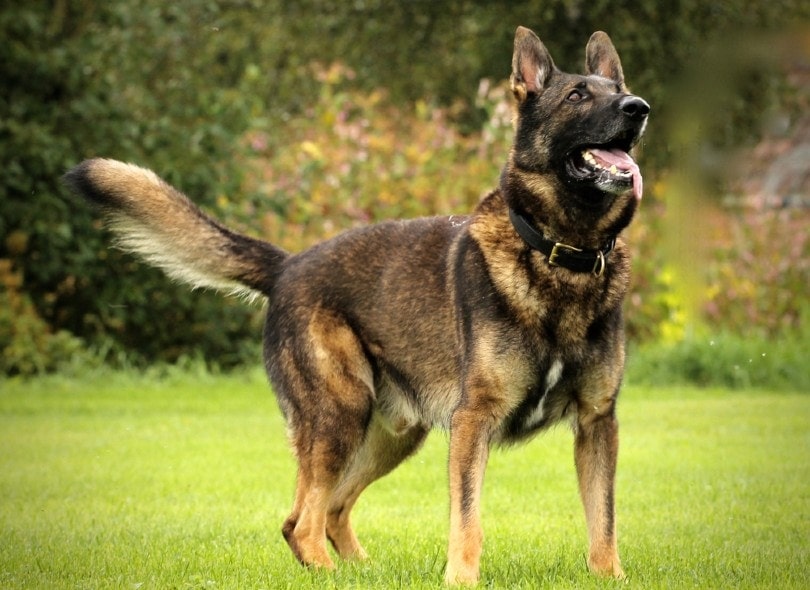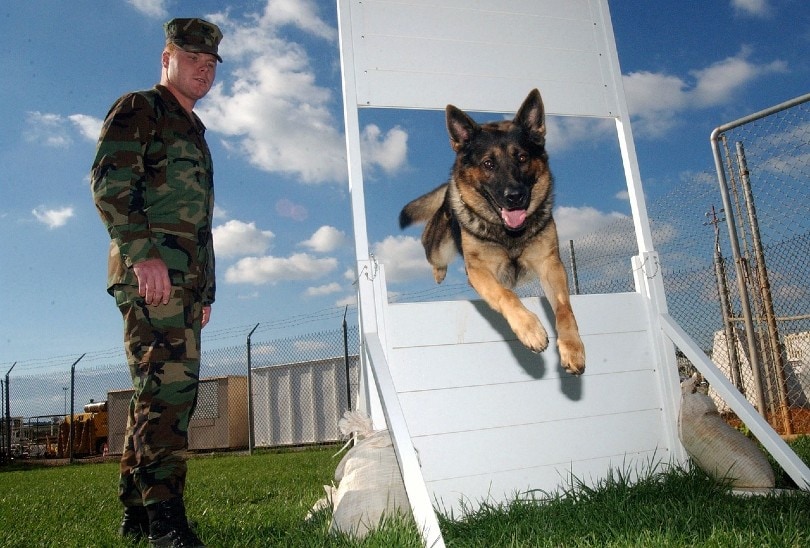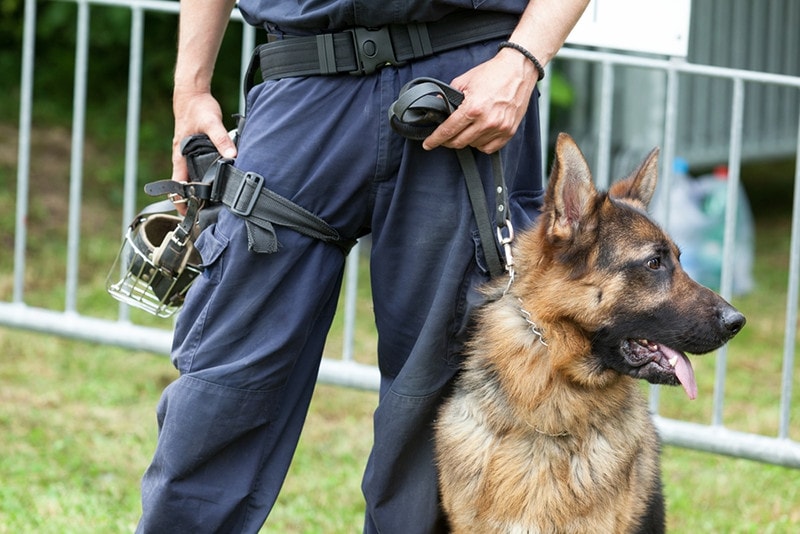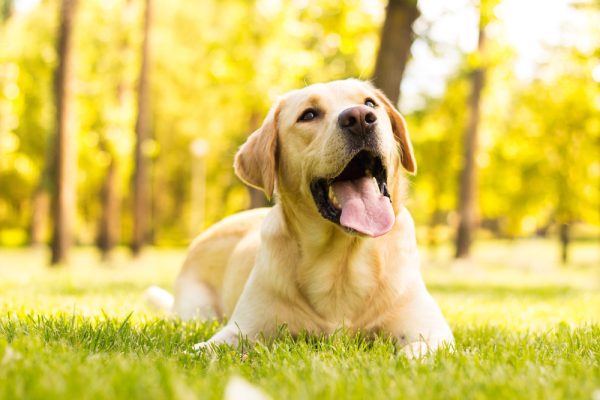In this article
Having a dog in the house can make you feel safer no matter what breed they are. However, if your pet is an intimidating large breed like a German Shepherd, you’re getting a lot more! Loyal, intelligent, and naturally protective, most German Shepherds display some guarding tendencies even without training.
If you are eager to channel those instincts further, we’ve got your step-by-step guide on how to train a German Shepherd to be a guard dog. We’ll be specifically focused on teaching your dog to alert you by barking rather than protection or attack training. In this post, we use the term “guard dog” interchangeably with “protection dog” because many dog owners do, but it is important to keep in mind that guard dogs are considered working dogs and need specialized training.

Before You Begin
Before starting guard dog training with your German Shepherd, assess their temperament to determine if they are suited for this kind of work. Nervous, frightened, or uncontrolled dogs should not participate in guard dog training. They may react incorrectly or aggressively, leading to a dangerous situation.
Poorly socialized German Shepherds should also avoid guard dog training. Early socialization is vital for the breed, especially if you plan to train them as guard dogs. The dog must be confident enough to read and respond to people and situations calmly.
Well-socialized, confident, calm German Shepherds should be able to accept guard dog training without becoming overly reactive or aggressive.
Supplies You Need for Training
You won’t need much to get started on training your German Shepherd. Treats and their collar and leash are essential supplies. Later in the training process, you may need to enlist other people to help you.
If you prefer clicker training, have your dog’s clicker handy. Remember to keep training sessions positive and never punish your dog or use negative reinforcements. German Shepherds are intelligent and usually eager to please their humans.

How to Train a German Shepherd to Be a Guard Dog
1. Start with Basic Obedience
For guard dog training to go smoothly, your German Shepherd should first learn basic obedience skills. Remember, as they participate in guard dog training, you want your dog to be in control and under control. Socialization plays a significant role in that process, but so does general obedience.
You can enroll your dog in training classes, work one-on-one with a certified trainer, or teach your dog on your own. The goal is for your dog to reliably follow basic commands such as sit, stay, down, and come before moving on to more advanced skills like guard dog training.

2. Teach Your Dog to Stop Barking
But wait, you might think, aren’t we supposed to be teaching my German Shepherd to alert me to danger? Why are we starting by training them on how to stop barking?
Most dogs don’t need any encouragement to bark, especially a naturally protective breed like the German Shepherd. However, if you don’t teach them when it’s time to stop, you might live in a really noisy house!
Choose a command for this skill, such as “Quiet” or “Enough.” When your dog barks, give the command and reward your pup when they stop. You may need to distract your dog with a noise or clap your hands to trigger the silence, but try to reward them to link the command and the behavior immediately.
If you’re using a clicker, give the command to stop barking, then click and reward when your dog obeys. Practice this skill until your dog reliably stops barking on command.
3. Teach Your Dog the Right Times to Bark
As a guard dog, you want your German Shepherd to alert you when someone is at the door or (worse) prowling around outside. You want them to understand the boundaries of your home and property. However, you don’t want them barking at every strange person and dog you encounter on a hike.
For this step, you’ll need the help of some other people. Ask a person unfamiliar with your dog to knock on the door. Encourage your dog to bark and alert you when this happens, possibly asking, “Who’s there? Who is it?” in an excited tone.
Praise your dog when they alert you, and then ask them to stop barking and settle before opening the door. This helps your dog learn that the human is happy when I let them know someone is here, but I don’t need to stay on high alert once they say it’s okay.
Don’t let your dog bark at strangers outside your house or yard. This is nuisance behavior and easily interpreted as aggression from a large breed like the German Shepherd.

4. Teach Your Dog the Property Lines
This step is about helping your dog understand that you only want them to bark at people outside when they enter your property. Otherwise, your dog will be constantly on alert and barking in a busy neighborhood. Your neighbors probably won’t appreciate it.
Take your dog outside on a collar and leash and walk around the edges of your property. Have a stranger (to your dog) walk into your yard. Reward and praise your dog if they bark to alert you.
Once the person retreats from the yard, ask your dog to stop barking, helping them learn when it’s time to settle down. Repeat this lesson, correcting or redirecting your German Shepherd if they bark when the person isn’t in your yard. Again, you don’t want your dog harassing strangers on the street, but specifically guarding your yard and home. Reach out to a veterinarian if you would struggle with this part of training.
If you need to speak with a vet but can't get to one, head over to PangoVet. It's our online service where you can talk to a vet online and get the advice you need for your pet — all at an affordable price!

5. Build Alertness and Confidence
Once your dog gets the hang of guard dog training, work to hone their alertness and confidence further. Again, you’ll need another person unfamiliar with your dog for these exercises. Ask them to try to come into your house or yard.
When your dog barks to alert you, ask the person to run away as your dog makes noise. Don’t let your dog chase them; give the command to stop barking as soon as the “threat” is out of your house or yard.
This exercise helps your dog learn to stay alert to potential threats and the appropriate way to respond. Having the person run away also helps increase your dog’s confidence. Again, never encourage your dog to chase or attack the fleeing “stranger.”


In Conclusion
As we mentioned, most German Shepherds learn quickly and should pick up guard dog training easily. If you’re struggling, don’t get frustrated and potentially resort to negative training tactics. Look for a professional trainer to help. Again, don’t try to move beyond these general guard dog or protection training guidelines into attack training without professional help. Owning an “attack dog” may not be legal in your area and could leave you liable if your dog injures another person or animal.
Featured Image Credit: wellphoto, Shutterstock



















